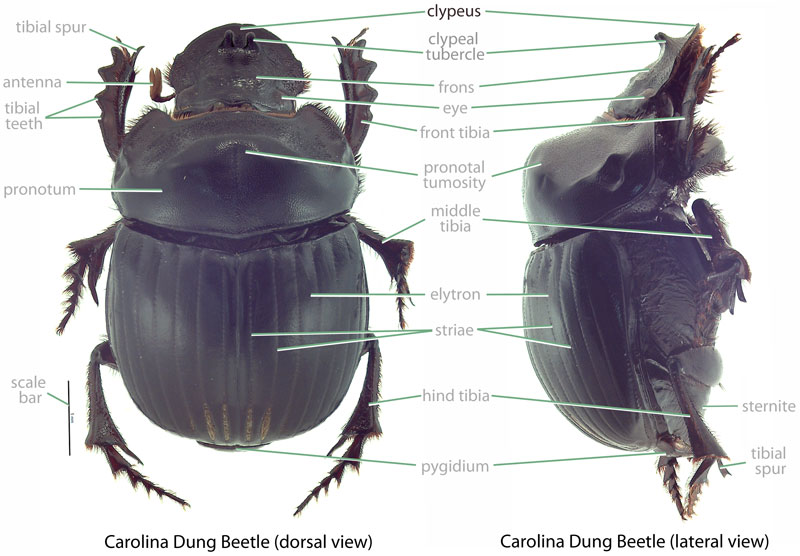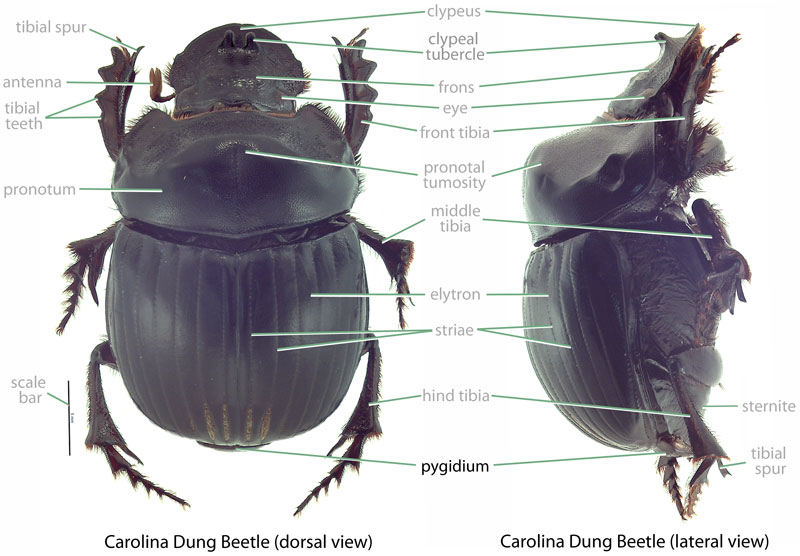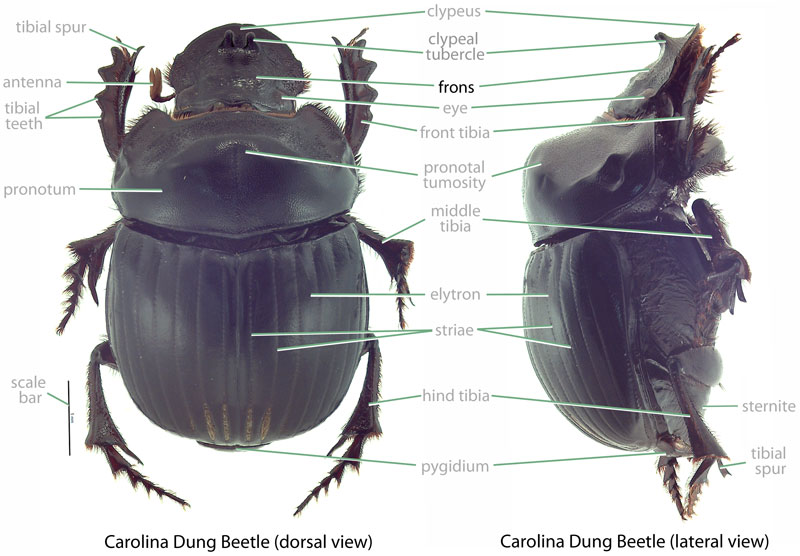We maintained several standards in the development of this tool. Terminology, diagrams, and morphological terms used in the diagnoses and keys can be found in the glossary.
What measurement standards did you use? For body length, we measured from the apexapex:
point or edge furthest from the body
of the clypeusclypeus:
part of the head anterior to the frons; the most anterior portion in dorsal view
 to the apexapex:
to the apexapex:
point or edge furthest from the body
of the pygidiumpygidium:
the last abdominal segment, usually exposed, not completely covered by the elytra
 .
.
How do you define “horns”? Head armature includes horns, tubercles, protuberances, or ridges that are located on the dorsaldorsal:
of or relating to the upper surface; opposite of ventral
surface of the clypeusclypeus:
part of the head anterior to the frons; the most anterior portion in dorsal view
 or fronsfrons:
or fronsfrons:
part of the head generally positioned between the eyes (posterior to the clypeus and anterior to the vertex) and visible dorsally
 . Pronotal (thoracic) armature includes horns, humps, pegs, tubercles, protuberances, or ridges that are located on the dorsaldorsal:
. Pronotal (thoracic) armature includes horns, humps, pegs, tubercles, protuberances, or ridges that are located on the dorsaldorsal:
of or relating to the upper surface; opposite of ventral
surface of the thorax.
Did you voucher any specimens? Many insect collections were examined as part of this research. Specimens were authoritatively identified, databased, and vouchered in entomology collections (specimens retain a “Hawaiian Scarabs” voucher label). Specimen vouchers allow this research to be repeatable.
Did you examine type specimens? To untangle valid species names for some species, type specimens (Ataenius pacificus, Ataenius liogaster, Ataenius nocturnus, Ataenius yasamatsui, Ataenius vandykei, Diasticus hawaiiensis, Holotrichia bipunctata, H. mindanaoana, Microserica guamensis) were borrowed from several museum collections.
What scientific classification did you use? Scarabaeoid taxonomy and classification follows catalogs by Krajcik (Scarabaeoidea, Cetoniinae, Rutelinae, Scarabaeinae) (Krajcik, 1998Krajcik, 1998:
Krajcik M. 1998. Cetoniidae of the world. Catalogue-Part I (Coleoptera: Cetoniidae). Typos Studio Most, Most, Czech Republic.; Krajcik, 1999Krajcik, 1999:
Krajcik M. 1999. Cetoniidae of the world. Catalogue-Part 2 (Coleoptera: Cetoniidae). Typos Studio Most, Most, Czech Republic.; Krajcik, 2006Krajcik, 2006:
Krajcik M. 2006. Checklist of the Scarabaeoidea of the world. 1. Scarabaeinae (Coleoptera: Scarabaeidae: Scarabaeinae). Animma.x. Supplement 3. Milan Kracjik, Plzen, Czech Republic.; Krajcik, 2008Krajcik, 2008:
Krajcik M. 2008. Checklist of the Scarabaeoidea of the world. 2. Rutelinae (Coleoptera: Scarabaeidae: Rutelinae), second edition. Animma.x. Supplement 4. Milan Kracjik, Plzen, Czech Republic.; Krajcik, 2012), Gordon and Skelley (Aphodiinae) (Gordon and Skelley, 2007Gordon and Skelley, 2007:
Gordon R and Skelley P. 2007. A monograph of the Aphodiini inhabiting the United States and Canada (Coleoptera: Scarabaeidae: Aphodiinae). Memoirs of the American Entomological Institute 79: 1-580.), Zidek (Trogidae) (Zidek, 2013Zidek, 2013:
Zidek J. 2013. Checklist and bibliography of the Trogidae (Coleoptera: Scarabaeoidea). Insecta Mundi 314: 1-38. full text (accessed 2015)), and Hawks (Lucanidae) (Paulsen and Hawks, 2014Paulsen and Hawks, 2014:
Paulsen M and Hawks D. 2014. A review of the primary types of the Hawaiian stag beetle genus Apterocyclus Waterhouse (Coleoptera, Lucanidae, Lucaninae), with the description of a new species. ZooKeys 433: 77–88. DOI: 10.3897/zookeys.433.8022).
How were distributions determined for each species? An important source for the scarab distribution maps was the "Hawaiian Terrestrial Arthropod Checklist" (Nishida, 2002Nishida, 2002:
Nishida G (editor). 2002. Hawaiian terrestrial arthropod checklist, fourth edition. Bishop Museum Technical Report 22: 1-313.). This list provided information regarding species that are established in the state, but does not provide specific information regarding which islands species are "established" versus "recorded but not established". There is a general paucity of such information available, particularly for commercially unimportant species. As such, all islands where an established species has been recorded are shown as "established" on the distribution maps for this tool.
Why did you include common names? To assist in accessibility of this tool, we included common names of scarab beetles. Unlike scientific names, however, common names are not unique. For example, the “oriental beetle” may have been used to refer to several species of scarab beetles such as Popillia japonica, Anomala orientalis, and Protaetia orientalis. Additionally, unlike the scientific name, common names can differ regionally. For example, the coconut rhinoceros beetle goes by the common names of “bhowara”, “mobar”, “munga”, “schalu doombi”, and “pálai vundu” in India; “gascooroominga” in Sri Lanka; “rhinoceros du cocotier” in France; “kumbang tanduk” or “kumbang badak” in Indonesia; “klappertor” in the Netherlands; and “Indischer nashornkaefer” in Germany (CABI 2015CABI 2015:
Anonymous. 2015. Exomala orientalis (oriental beetle). Invasive Species Compendium. Wallingford, UK, CABI International. Available from http://www.cabi.org/isc/datasheet/5510 (accessed 2015).). The ultimate arbiter for scientific purposes is the unique, scientific name. We use the standardized Common Names of Insects and Related Organisms provided by the Entomological Society of America. So, for example, within this tool, the “oriental beetle” refers to Anomala orientalis. When not available, common names were based on community usage.
How did you develop images for this tool? Images were taken with a Leica IC80 HD digital camera and processed using the Leica Application Suite version 4.0.1. Images were modified (background whitened, pins removed) using Photoshop CS 4 v. 11.0.2.